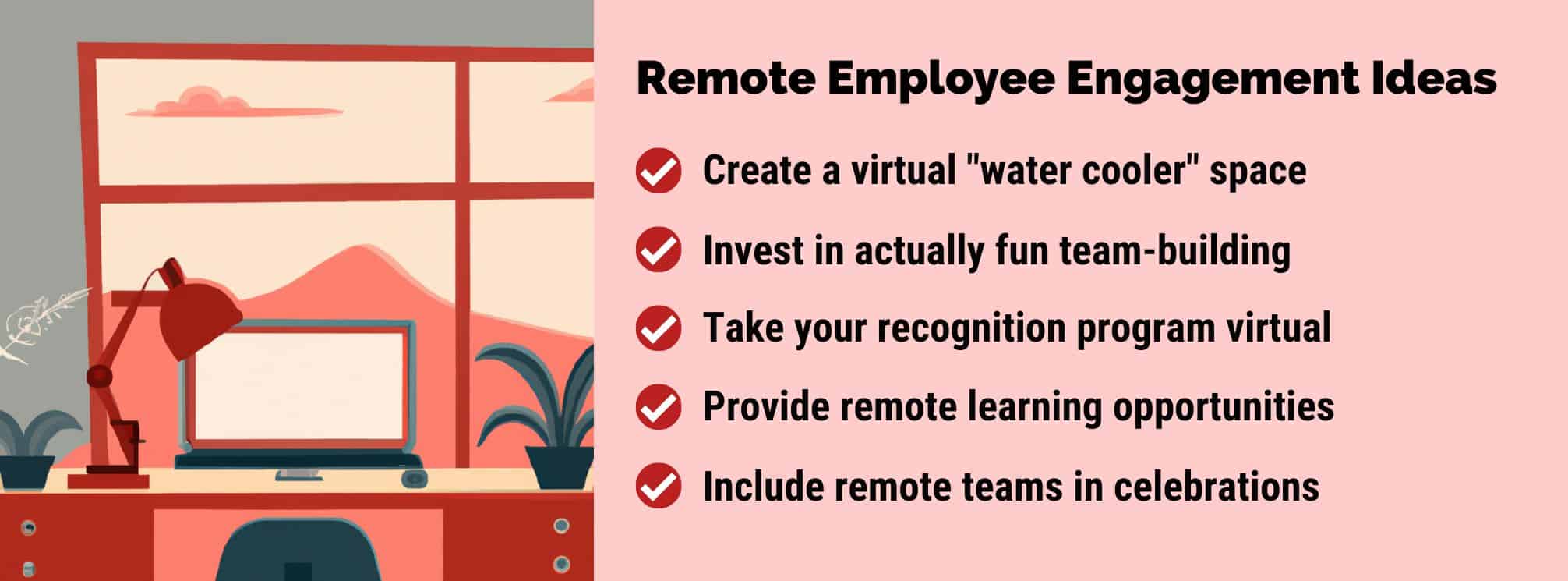
Remote work is here to stay, at least in some capacity. And that means that companies need to embrace new strategies and ways of working. In this blog, we’ll share 5 remote employee engagement ideas that can actually make a difference in how connected and supported your employees feel.
Let’s dive in!
Remote workers are people who perform their job duties and tasks from a location outside of a traditional office environment—such as their homes, co-working spaces, coffee shops, or anywhere with the internet.
Because they aren’t physically on-site, they use various forms of technology to stay connected with their colleagues, employers, and clients. Remote workers often communicate through online collaboration platforms, email, video conferencing, and instant messaging.
Although not as many people work remotely now compared to the pandemic, remote work is here to stay in some capacity. A study from Standford University found that remote work accounts for over 25% of paid, full-time workdays.
And that doesn’t reflect the number of people who want to work remotely full-time if not part of the time. 68% of Americans would like to be fully remote, and 92% want some type of hybrid work arrangement where they’re working from home at least one day a week.
This shift is largely due to many people now valuing flexibility even over pay. And younger generations in the workforce are demanding a healthier work-life balance.

Workplace engagement is a hot topic these days. We have a great resource hub on all things employee engagement if you want to learn more.
But basically, employee engagement is the level of motivation and commitment among your employees. It’s often reflected in their enthusiasm to participate at work, both with their daily tasks and by going above and beyond.
The reason employee engagement has become such an important topic is that it’s linked to many other indicators of business success, like productivity, safety, and retention.
But here’s the problem…we’re notorious for not doing a great job of engaging employees. It’s even harder when those workers aren’t physically present at work.
So, how do you engage the remote workforce? Let’s dive into five strategies you can implement this year.

When your workforce could be anywhere, fostering employee engagement requires innovative approaches. Companies need to get creative and not lose sight of the goal: creating supportive cultures where employees can thrive. This isn’t about recreating a virtual “beer keg” for workers—because, let’s face it, that doesn’t even work on in-office staff.
Instead, we need to focus on programs and rewards that boost morale, offer professional development opportunities, and help employees connect with one another.
Let’s talk about a few ways to do that.
I’m a full-time remote employee, but one of the things I miss about the office were those casual moments with my colleagues. Those coffee breaks or walks to get lunch.
These might be moments where big breakthroughs happen organically. But more often than not, it’s where camaraderie forms between colleagues.
These moments are really hard to replace in a remote environment. But that doesn’t mean we can’t try.
At theEMPLOYEEapp, we use an app called Donut in Slack that randomly assigns people to have coffee together every few weeks. What’s nice about these meetings is that they are casual with no work agenda. Of course, you could talk about work, but you aren’t limited to it. We find that these are the moments where we learn about each other’s hobbies, what’s challenging them at work, and how we can work better together cross-functionally.
Finding informal ways to communicate is the secret here. But it can’t be forced. Employees have to want to participate to get something out of this. But that’s okay! Not everyone in the office likes chit-chatting by the coffee station kitchen either.
You’re probably rolling your eyes that I’m talking about team-building. And with good reason. It doesn’t matter if you were in the office or not, team building activities can be done really poorly, earning them a bad reputation.
But I think that’s because they’re being done to force “fun” as opposed to teaching collaboration or some skill.
The goal of a team-building activity should be to foster stronger teamwork. So, picking what you do is more important than where the activity takes place. This is why your remote employees should never be left out of this kind of initiative. With the tools and technology now available to us, almost anything can take a virtual stage.
Here are a few ideas:

If your recognition programs unfairly favor office-based staff, odds are, you’re hurting the morale of everyone else. These programs have to be inclusive, and that includes where your people work from.
So, step one is to make sure everyone is included in your recognition program. Step two is to make sure you’re giving the right types of recognition. Our guide to recognition includes many more examples and best practices, but the basic premise is that you want to diversify how you give recognition, who it comes from, and what kinds of rewards are associated with it.
The key to getting that balance right is to find out what matters most to your teams. That includes:
Continuous learning and development is important. Not only does this tell your employees that you value them, but it can also increase performance and confidence.
Here are a few ideas for how to take learning virtual:
Although a team event might not be for everyone, some of your employees really want to celebrate the wins. So it’s important to think about how you take your team celebrations into the virtual world.
Here are a few remote team activities you could try:
The biggest key here is to not make any of this mandatory. Let people show up for five minutes, the whole time, or not at all.
[optin-monster slug=”z3iriuv89ypmndfrn8wk” followrules=”true”]
Embracing innovation for your remote employee engagement programs is crucial for unlocking the full potential of remote teams. And the best way to innovate is to empower your people and meet them where they are.
And remember that your leaders play a vital role in remote engagement because they set the example, drive the vision forward, and help remote employees feel connected to the business and valued.
Are you ready to invest in the right strategies and systems to engage your remote workforce?
[optin-monster slug=”gqorn0natkqgyrtjvr6i” followrules=”true”]
Sydney Lauro is the Demand Generation Manager for theEMPLOYEEapp. Prior to joining the team at theEMPLOYEEapp, Sydney worked in internal communications for Chipotle Mexican Grill. She uses her internal comms expertise and passion for improving communication and the employee experience to create content and share best practices to help other communications professionals.